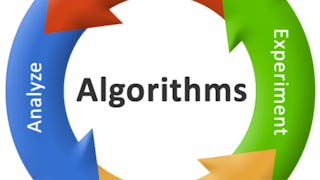Dieser Kurs deckt die wesentlichen Informationen ab, die jeder ernsthafte Programmierer über Algorithmen und Datenstrukturen wissen muss, wobei der Schwerpunkt auf Anwendungen und wissenschaftlichen Leistungsanalysen von Java-Implementierungen liegt. Teil I behandelt elementare Datenstrukturen, Sortier- und Suchalgorithmen. Teil II konzentriert sich auf Algorithmen zur Verarbeitung von Graphen und Strings. Alle Funktionen dieses Kurses sind kostenlos verfügbar. Wer den Inhalt vertiefen möchte, kann sich das Lehrbuch Algorithms, Fourth Edition (auf dem der Kurs basiert) besorgen oder die Website algs4.cs.princeton.edu besuchen, auf der eine Fülle von zusätzlichem Material zu finden ist. Dieser Kurs wird nicht mit einem Zertifikat abgeschlossen.



(2,021 Bewertungen)
Kompetenzen, die Sie erwerben
- Kategorie: Algorithmen
- Kategorie: Computerprogrammierung
- Kategorie: Graphentheorie
- Kategorie: Datenstrukturen
Wichtige Details
13 Aufgaben
Erfahren Sie, wie Mitarbeiter führender Unternehmen gefragte Kompetenzen erwerben.

In diesem Kurs gibt es 14 Module
Willkommen bei Algorithmen, Teil II.
Das ist alles enthalten
1 Video2 Lektüren
Wir definieren einen ungerichteten Graphen API und betrachten die Darstellungen der Adjazenzmatrix und der Adjazenzlisten. Wir stellen zwei klassische Algorithmen für die Suche in einem Graphen vor - die Tiefensuche und die Breitensuche. Wir betrachten auch das Problem der Berechnung von verbundenen Komponenten und schließen mit verwandten Problemen und Anwendungen.
Das ist alles enthalten
6 Videos2 Lektüren1 Aufgabe
In dieser Vorlesung untersuchen wir gerichtete Graphen. Wir beginnen mit der Deep-First-Suche und der Broadth-First-Suche in Digraphen und beschreiben Anwendungen von der Müllabfuhr bis zum Web-Crawling. Anschließend stellen wir einen auf der Tiefensuche basierenden Algorithmus zur Berechnung der topologischen Ordnung eines azyklischen Digraphen vor. Schließlich implementieren wir den Kosaraju-Sharir-Algorithmus zur Berechnung der starken Komponenten eines Digraphen.
Das ist alles enthalten
5 Videos1 Lektüre1 Aufgabe1 Programmieraufgabe
In dieser Vorlesung untersuchen wir das Problem des minimalen Spannbaums. Wir beginnen mit der Betrachtung eines generischen gierigen Algorithmus für dieses Problem. Als nächstes betrachten wir zwei klassische Algorithmen für das Problem - Kruskal's Algorithmus und Prim's Algorithmus - und implementieren sie. Wir schließen mit einigen Anwendungen und offenen Problemen.
Das ist alles enthalten
6 Videos2 Lektüren1 Aufgabe
In dieser Vorlesung untersuchen wir Probleme mit kürzesten Wegen. Wir beginnen mit der Analyse einiger grundlegender Eigenschaften von kürzesten Wegen und einem generischen Algorithmus für dieses Problem. Wir stellen Dijkstras Algorithmus für Probleme mit kürzesten Wegen mit nichtnegativen Gewichten vor und analysieren ihn. Als nächstes betrachten wir einen noch schnelleren Algorithmus für DAGs, der auch dann funktioniert, wenn die Gewichte negativ sind. Wir schließen mit dem Bellman-Ford-Moore-Algorithmus für kantengewichtete Digraphen ohne negative Zyklen. Wir betrachten auch Anwendungen, die von inhaltsbezogenem Füllen bis zu Arbitrage reichen.
Das ist alles enthalten
5 Videos1 Lektüre1 Aufgabe1 Programmieraufgabe
In dieser Vorlesung stellen wir die Probleme des maximalen Flusses und des minimalen Schnitts vor. Wir beginnen mit dem Ford-Fulkerson-Algorithmus. Um seine Korrektheit zu analysieren, stellen wir das Maxflow-Mincut-Theorem auf. Als Nächstes betrachten wir eine effiziente Implementierung des Ford-Fulkerson-Algorithmus, die die Regel des kürzesten augmentierenden Pfades verwendet. Schließlich betrachten wir Anwendungen, darunter Bipartite Matching und Baseball-Elimination.
Das ist alles enthalten
6 Videos2 Lektüren1 Aufgabe1 Programmieraufgabe
In dieser Vorlesung betrachten wir spezialisierte Sortieralgorithmen für Strings und verwandte Objekte. Wir beginnen mit einem Unterprogramm zum Sortieren ganzer Zahlen in einem kleinen Bereich. Dann betrachten wir zwei klassische Radix-Sortieralgorithmen - LSD und MSD Radix-Sorts. Als nächstes betrachten wir eine besonders effiziente Variante, eine Mischung aus MSD-Radixsortierung und Quicksort, die als 3-Wege-Radix-Quicksort bekannt ist. Wir schließen mit Suffixsortierung und verwandten Anwendungen.
Das ist alles enthalten
6 Videos1 Lektüre1 Aufgabe
In dieser Vorlesung betrachten wir spezialisierte Algorithmen für Symboltabellen mit String-Schlüsseln. Unser Ziel ist eine Datenstruktur, die so schnell wie Hashing und noch flexibler als binäre Suchbäume ist. Wir beginnen mit Multiway-Versuchen; als nächstes betrachten wir ternäre Suchversuche. Schließlich betrachten wir zeichenbasierte Operationen, einschließlich Präfixübereinstimmung und längstes Präfix, sowie verwandte Anwendungen.
Das ist alles enthalten
3 Videos2 Lektüren1 Aufgabe
In dieser Vorlesung betrachten wir Algorithmen für die Suche nach einer Teilzeichenkette in einem Textstück. Wir beginnen mit einem Brute-Force-Algorithmus, dessen Laufzeit im schlimmsten Fall quadratisch ist. Als nächstes betrachten wir den genialen Knuth-Morris-Pratt-Algorithmus, dessen Laufzeit im schlimmsten Fall garantiert linear ist. Dann stellen wir den Boyer-Moore-Algorithmus vor, dessen Laufzeit bei typischen Eingaben sublinear ist. Schließlich betrachten wir den Rabin-Karp-Fingerprint-Algorithmus, der auf clevere Weise Hashing verwendet, um die Teilstringsuche und verwandte Probleme zu lösen.
Das ist alles enthalten
5 Videos1 Lektüre1 Aufgabe1 Programmieraufgabe
Ein regulärer Ausdruck ist eine Methode zur Angabe einer Menge von Zeichenketten. Unser Thema in dieser Vorlesung ist der berühmte grep-Algorithmus, der feststellt, ob ein bestimmter Text eine beliebige Teilzeichenkette aus der Menge enthält. Wir untersuchen eine effiziente Implementierung, die unsere Digraphen-Erreichbarkeitsimplementierung aus Woche 1 nutzt.
Das ist alles enthalten
5 Videos2 Lektüren1 Aufgabe
Wir untersuchen und implementieren mehrere klassische Datenkompressionsverfahren, darunter Run-Length Coding, Huffman-Kompression und LZW-Kompression. Wir entwickeln effiziente Implementierungen von Grund auf, indem wir eine Java-Bibliothek für die Manipulation von Binärdaten verwenden, die wir zu diesem Zweck entwickelt haben und die auf Implementierungen von Prioritätswarteschlangen und Symboltabellen aus früheren Vorlesungen basiert.
Das ist alles enthalten
4 Videos1 Lektüre1 Aufgabe1 Programmieraufgabe
Unsere Vorlesungen in dieser Woche konzentrieren sich auf die Idee von Problemlösungsmodellen wie Maxflow und kürzester Weg, wobei ein neues Problem als Instanz eines dieser Probleme formuliert und dann mit einem klassischen und effizienten Algorithmus gelöst werden kann. Zum Abschluss des Kurses beschreiben wir das klassische ungelöste Problem aus der theoretischen Informatik, das sich auf das Konzept der Effizienz von Algorithmen konzentriert und uns bei der Suche nach effizienten Lösungen für schwierige Probleme leitet.
Das ist alles enthalten
4 Videos2 Lektüren1 Aufgabe
Die Quintessenz des Problemlösungsmodells ist die lineare Programmierung, und die Simplex-Methode zu ihrer Lösung ist einer der am häufigsten verwendeten Algorithmen. In dieser Vorlesung geben wir einen Überblick über dieses zentrale Thema des Operations Research und beschreiben seine Beziehung zu den Algorithmen, die wir betrachtet haben.
Das ist alles enthalten
4 Videos1 Lektüre1 Aufgabe
Gibt es ein universelles Problemlösungsmodell, auf das sich alle Probleme, die wir lösen möchten, reduzieren lassen und für das wir einen effizienten Algorithmus kennen? Sie werden vielleicht überrascht sein, dass wir die Antwort auf diese Frage nicht kennen. In dieser Vorlesung führen wir die Komplexitätsklassen P, NP und NP-vollständig ein, stellen die berühmte P = NP-Frage und betrachten die Implikationen im Zusammenhang mit den Algorithmen, die wir in diesem Kurs behandelt haben.
Das ist alles enthalten
6 Videos1 Lektüre1 Aufgabe
Dozenten


Empfohlen, wenn Sie sich für Algorithmen interessieren


Princeton University


Stanford University


Princeton University


Clemson University
Warum entscheiden sich Menschen für Coursera für ihre Karriere?




Bewertungen von Lernenden
2.021 Bewertungen
- 5 stars
93,57 %
- 4 stars
5,23 %
- 3 stars
0,49 %
- 2 stars
0,24 %
- 1 star
0,44 %
Zeigt 3 von 2021 an
Geprüft am 16. Apr. 2019
Amazing course! Loved the theory and exercises! Just a note for others: Its part 1 had almost no dependency on book, but this part 2 has some dependency (e.g. chapter on Graph) on book as well.
Geprüft am 12. Jan. 2024
Great quality of academic content. Mr Sedgewick is a great lecturer and the programming tasks, though hard, help you dive deep into the Java implementations.
Geprüft am 7. Feb. 2020
As always, I learned a lot from the courses from Professor Robert. Really great course, and I would like to recommend to anyone who is interested in programming neatly and elegantly.

Neue Karrieremöglichkeiten mit Coursera Plus
Unbegrenzter Zugang zu 10,000+ Weltklasse-Kursen, praktischen Projekten und berufsqualifizierenden Zertifikatsprogrammen - alles in Ihrem Abonnement enthalten
Bringen Sie Ihre Karriere mit einem Online-Abschluss voran.
Erwerben Sie einen Abschluss von erstklassigen Universitäten – 100 % online
Schließen Sie sich mehr als 3.400 Unternehmen in aller Welt an, die sich für Coursera for Business entschieden haben.
Schulen Sie Ihre Mitarbeiter*innen, um sich in der digitalen Wirtschaft zu behaupten.
Häufig gestellte Fragen
Sobald Sie sich angemeldet haben, haben Sie Zugang zu allen Videos und Programmieraufgaben.
Nein. Alle Funktionen dieses Kurses sind kostenlos verfügbar.
Nein. Gemäß den Richtlinien der Princeton University werden im Zusammenhang mit diesem Kurs keine Zertifikate, Zeugnisse oder Bescheinigungen ausgestellt.

